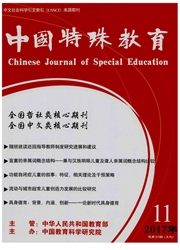

 中文摘要:
中文摘要:
通过以书面语(或手语)的语音、语义、无关三种干扰方式考察聋生基本水平概念语义分类能力情况,结果显示聋生基本水平概念语义分类能力弱于健听生。聋生基本水平概念语义分类能力成绩受刺激材料的性质影响较大,聋生在手语干扰下的语义分类成绩优于在书面语干扰下的语义分类成绩。语音对聋生语义分类影响不大,手形对聋生语义分类有显著影响,干扰词与靶子词具有主题关联联系时对聋生完成语义分类任务影响不大。采用书面语作为刺激材料可能会低估聋生的语义分类能力,支持手语词汇通达的交互激活模型。
 英文摘要:
英文摘要:
This study aims to probe into deaf students' ability in semantic categorization, by using written language (or sign language) in phonetic interference, semantic interference and marelated interference. The resuits show the following: the deaf students show a lower level of abihty in semantic categorization than the normal students; the stimuli affect the deaf students' scores in semantic categorization; they achieve higher scores under sign language interference than under written language interference; the phoneticized language has little effect on their semantic categorization; the hand shapes have a significant effect on their semantic categorization; and the interfering words and the target words, when showing thematic associations, have httle effect on their semantic categorization. According to the results, the use of written language as stimuli may cause the underestimation of the deaf children's ability in semantic categorization, as suggests that the results support the interactive activation model.
 同期刊论文项目
同期刊论文项目
 同项目期刊论文
同项目期刊论文
 期刊信息
期刊信息
